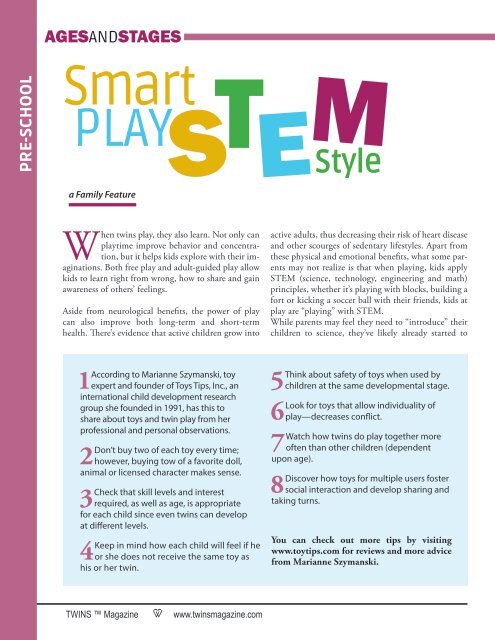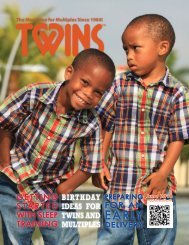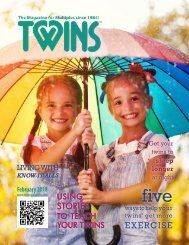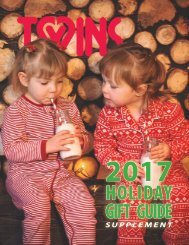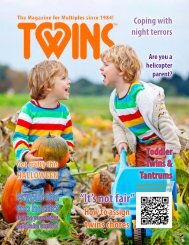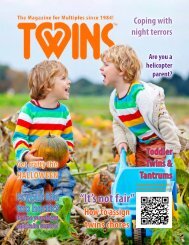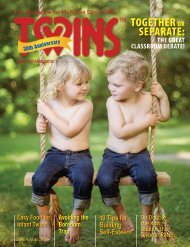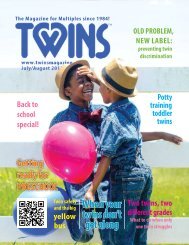2019_JulAugNEW
Create successful ePaper yourself
Turn your PDF publications into a flip-book with our unique Google optimized e-Paper software.
AGESANDSTAGES<br />
A TWINS Magazine<br />
PRE-SCHOOL<br />
Smart<br />
PLAY<br />
a Family Feature<br />
W<br />
hen twins play, they also learn. Not only can<br />
playtime improve behavior and concentration,<br />
but it helps kids explore with their imaginations.<br />
Both free play and adult-guided play allow<br />
kids to learn right from wrong, how to share and gain<br />
awareness of others’ feelings.<br />
Aside from neurological benefits, the power of play<br />
can also improve both long-term and short-term<br />
health. There’s evidence that active children grow into<br />
According to Marianne Szymanski, toy<br />
1 expert and founder of Toys Tips, Inc., an<br />
international child development research<br />
group she founded in 1991, has this to<br />
share about toys and twin play from her<br />
professional and personal observations.<br />
2Don’t buy two of each toy every time;<br />
however, buying tow of a favorite doll,<br />
animal or licensed character makes sense.<br />
3Check that skill levels and interest<br />
required, as well as age, is appropriate<br />
for each child since even twins can develop<br />
at different levels.<br />
4Keep in mind how each child will feel if he<br />
or she does not receive the same toy as<br />
his or her twin.<br />
Style<br />
active adults, thus decreasing their risk of heart disease<br />
and other scourges of sedentary lifestyles. Apart from<br />
these physical and emotional benefits, what some parents<br />
may not realize is that when playing, kids apply<br />
STEM (science, technology, engineering and math)<br />
principles, whether it’s playing with blocks, building a<br />
fort or kicking a soccer ball with their friends, kids at<br />
play are “playing” with STEM.<br />
While parents may feel they need to “introduce” their<br />
children to science, they’ve likely already started to<br />
5Think about safety of toys when used by<br />
children at the same developmental stage.<br />
6Look for toys that allow individuality of<br />
play—decreases conflict.<br />
7Watch how twins do play together more<br />
often than other children (dependent<br />
upon age).<br />
8Discover how toys for multiple users foster<br />
social interaction and develop sharing and<br />
taking turns.<br />
You can check out more tips by visiting<br />
www.toytips.com for reviews and more advice<br />
from Marianne Szymanski.<br />
understand it through everyday life and may even have<br />
a strong affinity for it. In fact, a report released by The<br />
Center for Childhood Creativity found kids are capable<br />
of developing complex STEM skills before they are even<br />
verbal. Knowing these skills are constantly developing,<br />
play time can be a fun way for parents to point out the<br />
science that makes things work.<br />
Stacking up math and science skills. Plastic building<br />
blocks are a classic for a reason; they give kids the opportunity<br />
to build a dream home, a castle, a car – the list<br />
goes on. By asking your child to build a house, person or<br />
monster, you are simultaneously introducing him or her<br />
to concepts such as balance, pivots and other mathematical<br />
and scientific theories. Another fun lesson you can<br />
bring to the set is using building blocks to practice addition,<br />
subtraction and multiplication skills. For example, a<br />
4-by-2 brick has eight studs on the top, while an 8-by-6<br />
brick has 48 studs. Help your kids make the connection<br />
by using the blocks to teach them how to build a better<br />
sense of numbers.<br />
Spring into action. Another classic toy that you may not<br />
have realized involves science is a metal spring toy. Generations<br />
of children have watched the bendable springs<br />
“walk” down the stairs in amazement. Challenge your<br />
child to explore and see at which angle the spring toy can<br />
“walk” the fastest. Make it even more fun by creating an<br />
obstacle course with books and other objects that may affect<br />
the trajectory to incorporate principles of physics and<br />
engineering. If your child is older, you can even use the<br />
toy to teach the basics of forces and waves by stretching it<br />
out then releasing it.<br />
Having your children play with science doesn’t have to<br />
involve test tubes and calculators; instead, you can harness<br />
the natural learning habits of your child. If you are<br />
looking for other ways to make learning fun, a program<br />
like ExploraVision can help. This K-12 STEM contest allows<br />
kids of all ages to create ideas for new technological<br />
innovations in response to real-world issues. Participants<br />
work on their projects to supplement their science education<br />
while also developing problem-solving, analytical<br />
and collaboration skills. A<br />
To learn more about the competition and how to enter,<br />
and for teachers to find free tips for engaging students, visit<br />
exploravision.org.<br />
TWINS Magazine A www.twinsmagazine.com<br />
July/August <strong>2019</strong> 15


